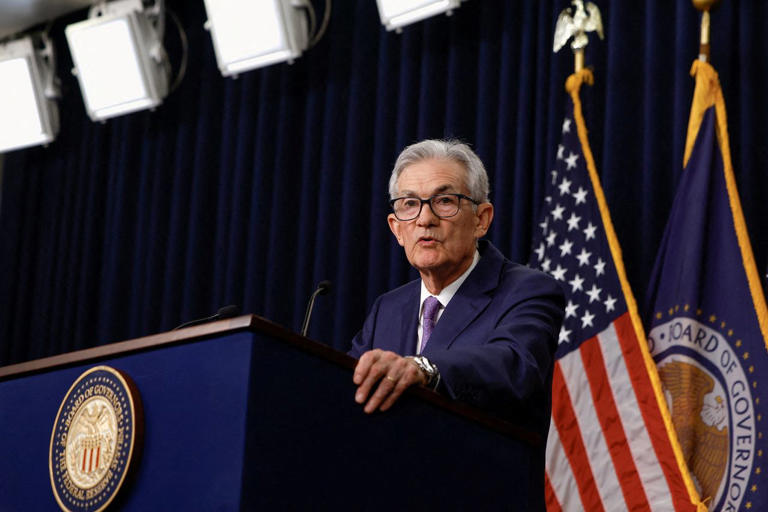The upcoming Federal Reserve meeting on Wednesday is anticipated to be a pivotal event, as investors and analysts keenly focus on how strongly officials will signal their intention to cut interest rates. The central bank is expected to maintain its benchmark short-term interest rate in the range of 5.25% to 5.5%, a level not seen in two decades. However, attention is now on whether the Fed will set the stage for rate reductions beginning in mid-September.
The Fed’s policy statement will be released at 2 p.m. Eastern time on Wednesday, followed by a news conference with Fed Chair Jerome Powell at 2:30 p.m. Here are the four most pressing questions ahead of this decision:
1. Where do officials set the bar for a September interest-rate cut?
Officials are expected to revise their post-meeting statement to indicate that a rate cut in September is increasingly likely. The language used in the statement, which is carefully crafted and debated by the 12 voting members of the Fed’s rate-setting committee, will be crucial. Even minor changes in wording can significantly influence market expectations. Key areas to scrutinize include:
- The first paragraph of the statement, which discusses recent developments in inflation and the labor market. Any acknowledgment of improved inflation data or changes in labor market conditions will be important.
- The second paragraph, which assesses the balance of risks between reducing inflation to the Fed’s 2% target and maintaining a strong labor market. A shift towards a more balanced risk assessment could signal a readiness to cut rates.
- The third paragraph, which provides forward guidance, outlining the conditions that would prompt the Fed to lower rates. Adjustments here will be critical in setting market expectations for future rate cuts.
Ed Yardeni, President of Yardeni Research, highlights that improvements in inflation data and a more balanced assessment of risks, combined with changes in forward guidance, will set the tone for Powell’s press conference. William English, a former senior Fed adviser, suggests that Powell might open the door to a September cut without making an explicit commitment, contingent on continued favorable inflation data.
2. Why are officials moving closer to cutting rates?
Earlier this year, the Fed contemplated rate cuts based on positive inflation data. However, unexpectedly strong inflation readings in February and March derailed these plans. Recently, inflation has been lower than anticipated, and there are signs of an economic slowdown, including a stagnant housing market and weak spending among low-income consumers. These developments suggest that higher interest rates are effectively curbing economic activity and inflation, potentially making Fed officials more comfortable with the idea of rate cuts.
Raghuram Rajan, a former governor of India’s central bank, notes that while some economic sectors are showing signs of slowing, others remain strong. This mixed picture might tempt the Fed to start cutting rates to achieve a soft landing, where the economy slows just enough to reduce inflation without triggering a recession. Rajan emphasizes that even after initial rate cuts, monetary policy would remain relatively restrictive.
3. Why not cut rates now?
Some former Fed officials and private-sector economists argue that the justifications for a September rate cut—improved inflation data and signs of slower spending and hiring—apply equally to a potential cut now. However, top Fed officials are not yet fully convinced that inflation is on a sustainable path towards the 2% target. Powell has previously described the first rate cut as a “consequential decision” that requires careful consideration. Despite the potential merits of a rate cut in July, such a move could appear reactionary and undermine confidence, as noted by William English, a professor at Yale School of Management.
4. What happens after the first cut?
While Powell is unlikely to delve deeply into future rate cuts during his news conference, these considerations are likely part of officials’ private deliberations. Once the Fed makes its first rate cut, there will be increased scrutiny and questions about subsequent cuts. Historically, the Fed’s quarterly economic projections have suggested that after the initial cut, rates could be reduced by a quarter percentage point approximately once every quarter. Although new projections will not be presented this week, the September meeting could provide a clearer outlook.
If the labor market weakens significantly between now and then, the Fed might consider more frequent rate cuts, potentially at consecutive meetings. The Fed’s schedule includes meetings in November and December. The November meeting poses a unique challenge, as it begins the day after the November 5 presidential election. Although the Fed has made policy changes around elections before, it strives to remain apolitical, which underscores the importance of clear, predictable, and deliberate communication during this period.
Richard Clarida, who served as Fed vice chair from 2018 to 2022 and is now a senior adviser at Pimco, suggests that if the Fed is confident enough to cut rates in September, subsequent cuts in November and December become plausible. The timing and sequence of these potential rate cuts will be closely watched by markets and could significantly influence economic and financial conditions.
